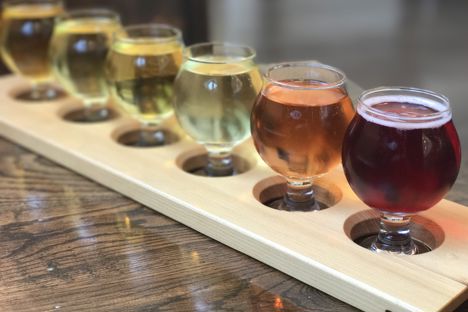
A guide to British cider
Not all British ciders are the same – in fact, there are dozens of different varieties created depending on the apples used and the technique of the cider-maker. Jane Peyton tells us more.
A guide to British cider
Not all British ciders are the same – in fact, there are dozens of different varieties created depending on the apples used and the technique of the cider-maker. Jane Peyton tells us more.
Britain is one of the world’s leading producers of cider, with fifty-six percent of all the apples grown in the UK used to create it – so it’s no surprise that we also produce the most diverse range of styles. Cider has refreshed the palates of countless Britons for millennia, but if you asked a person in the street how cider is made they would invariably say that it was brewed. It’s not – cider is made by pressing apples and fermenting the juice, more akin to wine than beer.
Cider can be made in dozens of different styles. ‘Real’ cider contains 100% (or almost 100%) freshly pressed apple juice, but the British market is dominated by apple-flavoured alcopops made by diluting juice concentrate from apples (that may not even have been grown in the UK). Legally cider in Britain only has to contain thirty-five percent juice, meaning that the remaining sixty-five percent is water, sugar, preservatives, caramel, colourings and other additives. Rather than taking months (if not years) to make, the majority of cider consumed in this country is an industrial product made in around three weeks. Imagine the indignation of winemakers around the world if producers of grape-flavoured alcoholic drinks were allowed to market them as wine!
But let’s return to real cider. Just like wine with grapes, the finished cider will be influenced by the variety of apple. The easiest way of categorising British styles is to focus on the type of apple used to produce the cider – cider apples or domestic eating and cooking apples. There is a vast difference between the two in the characteristics of the finished cider.
In Britain there is a geographical split in the types of apples used to make cider. In the West Country (Somerset, Herefordshire, Worcestershire, Devon, Gloucestershire and Monmouthshire) traditional cider apple varieties are grown in the local orchards. They have evocative and poetic names such as Handsome Norman, Foxwhelp and Porter’s Perfection. Kent, Sussex and eastern counties such as Suffolk are the traditional heartlands of cider made with domestic apples familiar to anyone with a fruit bowl – Gala, Russet and Cox are just three popular varietals that end up in a glass of cider.
Cider apples come in four categories – bittersharp (tannic and acidic), bittersweet (tannic and sweet), sharp (acidic) and sweet. Cider-makers may blend them to get the best out of each cultivar, or if an apple has the ‘Holy Trinity’ (as cider-makers call it) of tannins, acidity and sweetness, then single-varietal ciders are possible. Kingston Black is a bittersharp apple that produces very dry and tangy single-varietal ciders that fans rhapsodise over. For drinkers unfamiliar with these types of cider, my suggestion is to think of them as wine. If you enjoy tannic red wines then choose a cider made from West Country cider apples. If lighter white wines are your tipple then cider made with eating and cooking apples should appeal. These are categorised as acidic ciders with a refreshing zestiness and a delicate mouthfeel.
There are also categories for ciders that include fruit and flowers (for instance blackberry and elderflower) or herbs and spices (such as cinnamon and ginger). Cider with hops is a separate style – the hops often bestowing a subtle lemon character – as is barrel-aged cider, where the wood confers flavours such as vanilla and whisky. With all these categories depending on who is making them and where, they will contain cider or domestic apples – in some cases a combination of the two.
And then there is ice cider. Ooh la la! If you are familiar with Sauternes dessert wine and enjoy intense sweetness, then ice cider will hit the spot. Sauternes acquires its distinctive flavour with the aid of a fungus called Botrytis cinerea (aka noble rot) which shrivels the grapes to raisins on the vine thereby intensifying the sugars. With ice cider made in Britain the harvested apples or the juice are frozen. This concentrates the sugar so the resulting cider is exceedingly sweet and has a syrup-like texture. In countries with cooler climates the apples will freeze on the branch but it is never cold enough for that to happen in the UK. The most successful ice ciders have a combination of tannins and acidity which act as a balance to the sugar. Try an ice cider with salty blue cheese and prepare for flavour fireworks.
We’ve done dessert so let’s finish with a nightcap and pour a cider brandy. In 1989 the Burrow Hill cidery in Somerset was granted the UK’s first cider-distilling license and it markets the spirit through The Somerset Cider Brandy Company. Now a number of small producers make brandy by distilling cider and aging it in oak barrels for a minimum of three years. Expect a fruity, complex, smooth sipping session as you marvel at the diversity of the apple and Britain’s role in perpetuating cider – one of the most ancient libations.


